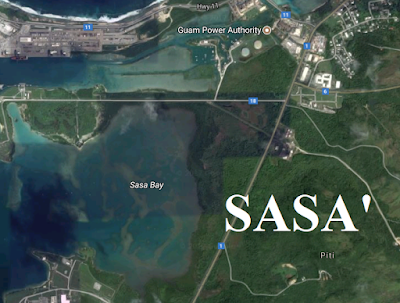VICTORIANO JOANINO
Clerk of the Guam Court
1900-1902
My great grandfather Victoriano Joanino was clerk of the Guam Court in the first years of the American Naval Government. He was thus involved in many of the comings and goings of Guam society in those days, including the criminal!
In those days before typewriters and tape recorders, everything documented in court was done by hand, and Victoriano wrote thousands of pages of court records, from transcripts of testimonies to certificates to legal forms.
One such court case put him in the right place at the right time, at least for one suspect.
A man farming in Piti, Antonio de la Cruz, came home one day to find that his wooden chest (kaohao) was broken into. He had spent the night prior to this at his mother-in-law's, together with his wife, and no one was in his own house the night the chest was broken into.
Missing from the chest was 19 pesos, a good sum of money in those days. Then he discovered that a good quantity of pugas (raw, harvested rice) was also missing.
Investigating the surroundings, he noticed footprints of at least two people outside the house, and the prints of a karabao. He followed these prints and they lead him to the house of one Vicente the Tagålo (Tagalog). Antonio believed he had found his suspect.
This Vicente was Vicente Mejos Gonzales, a Filipino from the town of Bangar in the province of La Union, in the Ilocano-speaking region of the Philippines. For Chamorros, all Filipinos are Tagålo (Tagalog), even if that person is Visayan, Ilocano or what have you. Gonzales was, in fact, far from being Tagalog, but his own neighbor, Antonio Cruz, called him Vicente the Tagålo. In the court record seen above he is named "Vicente de tal @ tagalo." "De tal" means "so and so" and @ stands for "alias," or "also known as." Since the court had only Antonio Cruz's information thus far, no one knew Vicente's full name yet, so he was called Vicente the Tagalog.
Government investigators went out to Antonio's ranch house in the Sasa' area of Piti, a good place for growing rice in its swampy terrain. They looked over the ranch house and took measurements of the footprints. Then they went to look for Vicente the Tagålo.
When they found him, they encountered a slight difficulty. Vicente was not Tagalog at all but rather Ilocano. He had married a Chamorro-Chinese mestiza, Maria Mafnas Champaco. Being unschooled, Vicente could not speak either Spanish nor Tagalog, and his Chamorro was very basic. If he had to testify, he could do it in only one language - Ilocano. Where would they find an Ilocano speaker who also spoke excellent Spanish?
Well, it just so happened that the court secretary, Victoriano Joanino, was Ilocano. Although the court clerk or secretary shouldn't act as interpreter, Victoriano had no choice but to translate for Vicente, suspected now of being the robber.
When all was said and done, no charges were brought against Vicente Gonzales. The court determined that there just was not enough evidence to point fingers at anybody, and the robber was never identified.
All of which made very happy one Vicente the-not-so Tagålo.
But I wonder what poor Vicente would have done if Victoriano Joanino had not been the court clerk that day when he was called before the judge. How would he have given his side of the story? My great grandfather was in the right place at the right time to act as Ilocano interpreter for Vicente.
The Sasa' area south of Piti where Antonio had his ranch house



:)
ReplyDelete